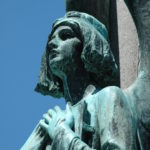

Born in 1878 in Sainte-Élizabeth-de-Warwick, in the Bois-Francs region, Alfred Laliberté received training at the Conseil des arts et manufactures in Montréal; when he was 23, he went to study at the prestigious École des beaux-arts de Paris. He returned to Canada in 1907 and became a professor at the École des beaux-arts de Montréal in 1922.
A prolific artist, Laliberté produced more than 920 sculptures. Some were portrayals of important historical figures, including statues of Father Brébeuf and Father Marquette in Québec City, whereas others evoked rural traditions and legends, such as the series of bronzes commissioned by the Québec government in 1928. Laliberté was long regarded as Québec’s “national sculptor”.

Artwork description
The work comprises five large bronze figures attached to a white granite pedestal. The whole stands just over 9 metres high. Atop, Saint Joseph carries the child Jesus in his arms with the customary lily in his hand. Below them on the base’s four faces stand an angel, each an allegory, respectively, of the Church, Knowledge, Labour, and Fatherland. Various citations engraved on the base make mention of Saint Joseph. Interestingly enough, Alfred Laliberté, already having made several self-portraits, actually seems to have used his own face to model that of Saint Joseph!
So, while the crypt church of the Oratory had been inaugurated in 1917 and the gardens were in the midst of being created by the main architects of the project, Dalbé Viau and Alfonse Venne, Alfred Laliberté was commissioned to create the monument in 1922. Drawings of the pedestal were reviewed by Venne. Laliberté fashioned clay models of the statues and plaster versions were produced for approval before being cast. The blessing of the monument took place on June 10, 1923 before a crowd estimated at 30,000 persons. It would be one of the few major religious works realized by the sculptor.
The main Latin inscription on the base “Ite ad joseph” means “Go to Joseph.” It is a reference to the patriarch Joseph, in the book of Genesis, who was the son of Jacob and Rachel and whose story has parallels to that of Saint Joseph, the protector of the child Jesus. Thus, at the behest of the founder of the Oratory, Saint André Bessette (1845-1937) the monument suggests to pilgrims and visitors (without regard to age, gender, nationality, or religion) to direct their prayers and their petitions to Saint Joseph. Saint Joseph’s Oratory of Mount Royal hopes to be a haven of beauty, peace, and hope right in the heart of the city of Montreal.



